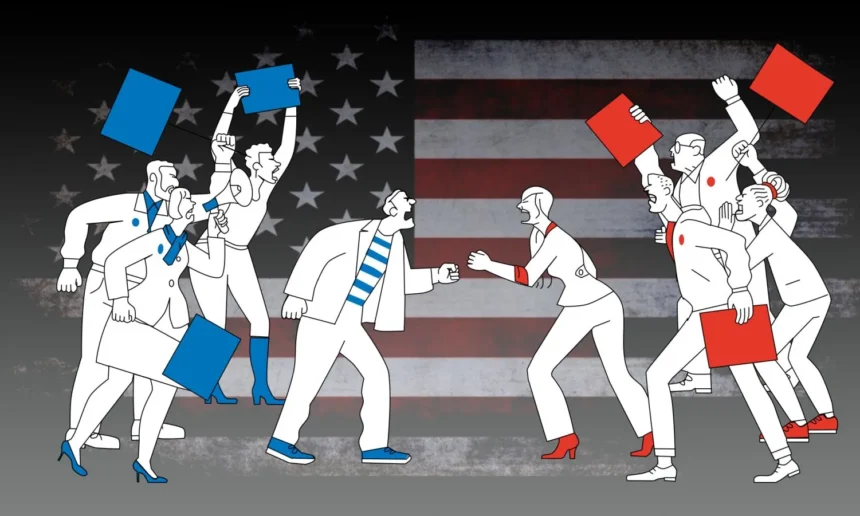Polarization in the digital age exacerbates this already complex issue of societal and political division. While differing views naturally occur within any society, the digital landscape amplifies the alignment of diverse ideologies onto a single spectrum. This reduction in the richness of public discourse creates a potent ‘Us’ versus ‘Them’ dynamic, which transcends simple disagreement to influence identity politics.
In such a polarized environment, the middle ground becomes a no-man’s land. The focus shifts from finding common solutions to defeating the “other side,” often at any cost. This is where the real danger lies for democratic systems. Democracies rely on compromise, dialogue, and a certain level of trust among its citizens and institutions. Polarization erodes these democratic cornerstones, leading to gridlock in the best-case scenario. Legislative bodies become arenas of conflict rather than cooperation, and laws that require bipartisan support become almost impossible to pass.
In more severe cases, the consequences are even graver. Extensive research in political psychology has demonstrated that when an “Us vs. Them” mentality becomes deeply ingrained, it can result in the dehumanization of the opposing group. This not only escalates intergroup conflict, but also paves the way for the weakening of democratic norms and institutions.
The Digital Age: Catalyst for Unprecedented Polarization
The digital age has transformed information access but also fueled a surge in political and social polarization. A Pew study shows a 36% increase in ideological gaps between U.S. Republicans and Democrats since 1994 on issues like healthcare. Polarization has accelerated more in the U.S. than in other nations. Factors like racial divisions and partisan media could be part of the reason. However, this issue is global. It influences situations from Brexit to Middle East tensions.
Lies spread six times faster than the truth.
This increase in polarization is the result of a confluence of factors that have intensified in recent decades. The accessibility to information has a double edge. On one hand, it has democratized knowledge, allowing more people to engage in political and social discussions. On the other hand, information overload has created an environment where extreme narratives and misinformation can flourish. People feel overwhelmed by the data flood. This often leads to oversimplifying complex issues. As a defense mechanism, they adopt extreme stances.
Moreover, the design of social media platforms contributes to this problem. The algorithms aim to boost user engagement. They often promote content that triggers strong emotions. As a result, moderate opinions are drowned in a sea of extremism, and common ground erodes quickly.
Social Media: Amplifiers of Division in the Digital Age
Social media has transformed how we talk, yet fuels political and social divides. Meant for connection and discussion, these platforms now enlarge divisions and make extreme opinions mainstream. Researchers from the Massachusetts Institute of Technology showed that lies spread six times faster than the truth. The study found that people are 70% more likely to share false or polarizing information online than balanced, objective information.
Social media algorithms work on positive feedback. The more you engage with certain content, the more you see it. This creates an “echo chamber effect.” People only see opinions that reinforce their own beliefs. This limits diverse views and fuels polarization. Moreover, the design of these platforms favors brevity and speed, often reducing complex arguments to sensational headlines or short posts.
The “attention economy” amplifies polarization on social media. Extreme, emotionally charged content gets more interactions and visibility. This loop silences moderate voices and boosts extreme opinions.
Economic Inequality: The Breeding Ground for Polarization
Economic inequality is a significant underlying factor contributing to the rise of polarization in the digital age. According to a World Bank report, countries with high levels of inequality tend to experience sharper political and social tensions. This inequality creates fertile ground for distrust and animosity between different socioeconomic groups, which in turn fuels polarization. In a setting with scarce or uneven resources, people often adopt extreme views. They use this as a defense or to assert their identity in a society they see as unfair.
In systems where economic and political power are closely linked, lower socioeconomic groups often feel marginalized.
Economic inequality also translates into unequal access to quality education, perpetuating a cycle of misinformation and polarization. People with limited access to quality education are more prone to misinformation. They are especially vulnerable on social media, where false information thrives. Economic inequality also becomes a political issue, adding to polarization. Political leaders exploit these divisions for gain, using tactics that deepen divides instead of solving the root causes of inequality.
Inequality also impacts political representation. In systems where economic and political power are closely linked, lower socioeconomic groups often feel marginalized. This disenchantment leads to distrust in democratic institutions. Support for extremist leaders who promise to disrupt the system grows, worsening polarization.
The Role of Political Leaders: Strategies of Division and Power
Political leaders wield substantial influence in polarization, particularly in the digital age, where their actions can go viral in minutes. Figures like Donald Trump, Jair Bolsonaro, and Viktor Orbán have employed divisive tactics, demonizing opponents and promoting conspiracy theories to consolidate power.
Leader-driven polarization is not a new phenomenon, but the digital age has expanded its reach and accelerated its impact. Social media allows leaders to communicate directly with their followers, bypassing traditional media filters. This gives them an unprecedented platform to disseminate their message and mobilize their base. However, it also creates an environment where misinformation and extreme narratives can proliferate unchecked.
Polarization can lead to the erosion of democratic norms and the emergence of authoritarianism.
Furthermore, top-down driven polarization has a domino effect on society. When leaders adopt polarizing tactics, this translates into greater division between their followers and those of the opposing party or group. Polarization becomes an effective strategy for mobilizing the voter base, but at the expense of social cohesion and effective governance. In the worst-case scenarios, polarization can lead to the erosion of democratic norms and the emergence of authoritarianism.
It is crucial to recognize the role that political leaders play in polarization to effectively address the issue. This involves both holding leaders accountable for their actions and fostering a political environment where extremist rhetoric and divisive tactics are less effective. Ultimately, the quality of political leadership is a determining factor in the health and stability of any democracy, and its role in polarization cannot be ignored.
Impact on Democracy and Governance: The Silent Erosion of Institutions
Polarization has a corrosive impact on democratic institutions and effective governance, setting off a domino effect that leads to democratic decay. As public faith in governmental institutions wanes, democracies become increasingly susceptible to democratic backsliding.
This phenomenon undermines public debate, paralyzes decision-making, and fosters extremism. In a highly polarized environment, the government’s ability to tackle complex and urgent issues is severely compromised. Policies transform into ideological battlegrounds rather than pragmatic solutions to real-world problems.
Polarization also impacts public perception of democratic institutions.
In a democratic system, polarization can lead to legislative paralysis. When political parties are deeply divided, the passage of laws and policies becomes increasingly challenging. This is evident in the United States, where Congress has faced government shutdowns due to bipartisan disagreements. Furthermore, polarization can erode democratic norms, tempting political actors to undermine institutions for short-term gains, harming democracy’s health.
Polarization also impacts public perception of democratic institutions. Trust in these institutions erodes when citizens see their leaders unable to overcome partisan divisions to address national challenges. This can lead to a dangerous cycle where distrust in institutions further fuels polarization, creating a vicious circle that is difficult to break.
Deep social divides and sharp political tensions resulting in polarization diminish the public’s ability to curb the illiberal tendencies of elected politicians. When electorates are highly polarized, even voters who value democracy are willing to sacrifice democratic principles in order to elect politicians who defend their interests.
Polarization contributes to endangering democratic rules, among other reasons, because polarized supporters prefer to violate these rules when their acceptance is the price for countering a leader’s authoritarian tendencies. Polarization erodes an electorate’s ability to resist authoritarianism while offering authoritarian leaders the opportunity to undermine democracy without suffering the consequences of their actions. When polarization is of an ethnic or nativist nature, it further incites electoral violence.
It’s worth noting that the erosion of democratic norms and institutions is not always overt or immediately visible. Often, it occurs subtly, through gradual changes in legal frameworks, the politicization of independent agencies, or the manipulation of electoral systems. This “silent erosion” makes it even more challenging to diagnose and address the issue, requiring vigilant public oversight and robust civil society engagement to safeguard democratic integrity.
Strategies for Depolarization: A Path Toward Social Cohesion and Political Stability
Combating polarization is a complex task that requires a multifaceted approach and the involvement of multiple stakeholders, from individuals and communities to political leaders and institutions. There is no “silver bullet” to solve this issue, but several strategies have proven effective in mitigating its most harmful effects.
One of the most promising strategies is the reform of social media algorithms. By adjusting these algorithms to prioritize accuracy and plurality over mere engagement, the echo chamber effect that fosters polarization could be reduced. Initiatives like “Braver Angels” in the United States aim to encourage dialogue and find common ground among polarized citizens. These grassroots efforts can be especially effective when combined with changes in how information is presented and consumed online.
Polarization is a challenge that affects us all, regardless of our political affiliation or socioeconomic background.
Civic education is another powerful tool in the fight against polarization. Educational programs that promote critical thinking and empathy can help prepare future generations to navigate an increasingly divided world. Education can act as an antidote against misinformation and equip individuals with the skills needed to engage in public debates more effectively and respectfully.
Political leaders also have a crucial role in depolarization. They must commit to moderation and the pursuit of consensual solutions rather than resorting to polarizing tactics to mobilize their base. The responsibility of the media is equally important; they should strive to provide balanced coverage and avoid the sensationalism that fuels polarization.
To enhance the discussion, it’s important to note that depolarization strategies should be culturally and contextually sensitive. What works in one country may not be applicable in another due to different historical, social, and political dynamics. Therefore, a nuanced approach that considers these factors is essential for the successful implementation of depolarization initiatives.
Polarization in the Digital Age: A Global Challenge, But Not Insoluble
Polarization in the digital age is a complex and multifactorial phenomenon that threatens social cohesion and political stability worldwide. From the information age to social media, economic inequality, and the role of political leaders, multiple factors contribute to this growing issue. However, with a deep understanding of its roots and mechanisms, it is possible to mitigate its most damaging effects.
The key to addressing polarization lies in a combination of institutional reforms, changes in media practices, and robust civic education. Additionally, political leaders must assume special responsibility to avoid tactics that foster division and instead seek solutions that unite people around common goals. Grassroots initiatives, such as community dialogues and educational programs, can also play a crucial role in building common ground and promoting a more informed and engaged citizenry.
It’s important to recognize that polarization is not a problem that can be solved overnight. It requires sustained effort and political will to implement meaningful changes. But the costs of not addressing this issue are too high to ignore. The erosion of trust in democratic institutions, the weakening of social fabric, and the rise of extremism are threats we can ill afford to overlook.
Ultimately, polarization is a challenge that affects us all, regardless of our political affiliation or socioeconomic background. But it is also a challenge that we can face and overcome together, through collective action, institutional reform, and a renewed commitment to democratic values and human dignity.
The global nature of polarization means that solutions must be adaptable and flexible. Strategies that work in one context may need to be tailored to fit the unique challenges and opportunities of another. This adaptability is essential for the long-term success of any depolarization efforts.






